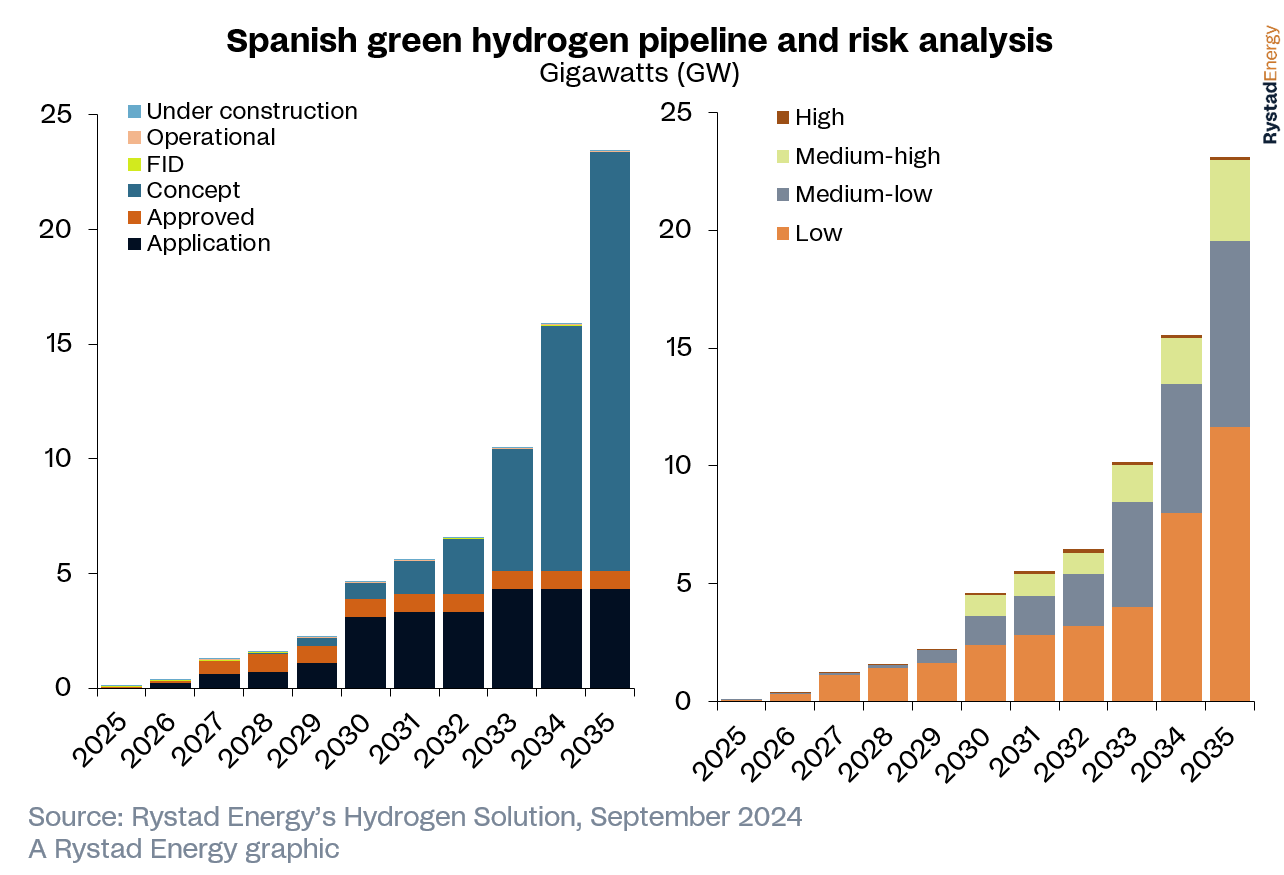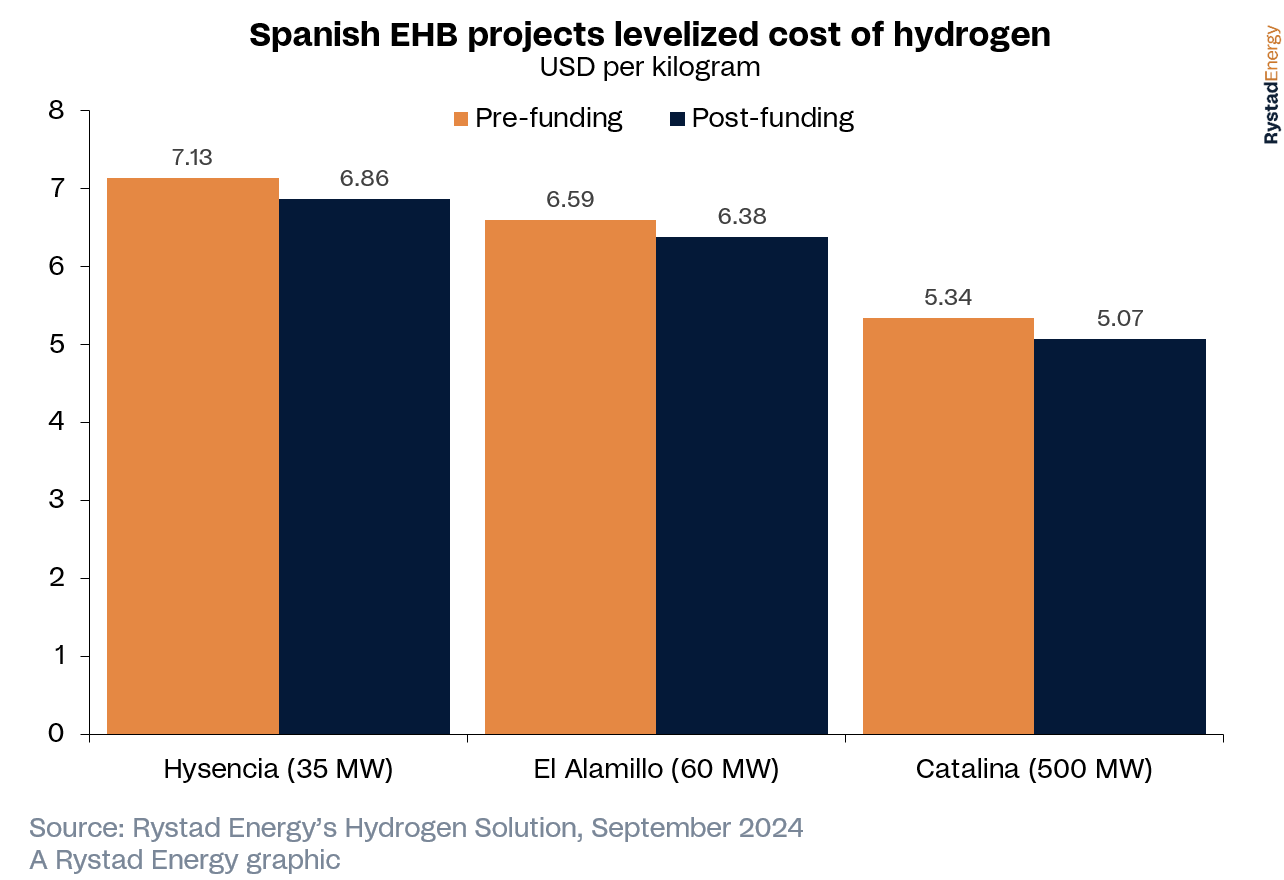Spain is an established green energy leader in Europe, with its significant wind and solar generation capacity giving renewable power generation over a 50% share of the nation’s total electricity mix. The next phase of Spain’s decarbonization strategy appears to be harnessing its renewable potential for hydrogen. According to research by Rystad Energy, Spain can achieve approximately 5 GW of installed electrolyzer capacity by 2030. However, to meet its target of 11 GW—the highest in the European Union (EU)—the country will need additional support from its subsidy programs. Germany follows closely in second place with a target of 10 GW by 2030, but is currently projected to reach 4.5 GW, according to Rystad Energy's analysis.
Spain's optimal conditions for renewable energy, coupled with supportive policies, have positioned it as one of the most cost-effective regions for green hydrogen production. While the global hydrogen market has not met investors’ early and enthusiastic expectations, with only a few operational projects —such as the Puertollano green hydrogen plant, with capacity of 20 megawatts (MW) in Spain itself —the outlook is more promising. Our projections indicate Spain could significantly boost green hydrogen production by 2030, with most projects considered low-risk and on track for timely commissioning, thanks to strong government support. This funding is already driving progress, as seen in BP’s recent final investment decision for the first 25-MW phase of the Castellón refinery hydrogen plant, which could expand to 2 GW of electrolysis capacity by 2035.
The European Hydrogen Bank (EHB) has highlighted the advantages and interests in the Spanish hydrogen sector, awarding subsidies to three major Spanish initiatives via a pilot auction which attracted 130 bids from European nations in total, including 46 from Spain. EHB support is complemented by the Spanish government's significant €794 million ($885 million) state aid package under the EU’s IPCEI Hy2Use program, aimed at supporting hydrogen-related infrastructure including large-scale electrolyzers and transportation networks for the production, storage and distribution of low-carbon hydrogen. Moreover, Spain’s hydrogen sector is set to benefit from a €2.3 billion subsidy program recently announced by the government, of which €1.2 billion will be dedicated to developing renewable hydrogen hubs and €750 million to strengthening the nation’s green technology supply chain. With this Spain joins other European countries such as Germany, France, Netherlands in recently opening billion-dollar funding programs and auctions.
Spain is positioning itself as a key player in Europe's hydrogen market but has yet to outline plans for generating domestic demand. Unlike Germany, which has set ambitious targets and ranks second in production capacity, Spain could focus on becoming a net exporter, particularly to Germany, which faces challenges due to less favorable renewable energy conditions. Seizing this opportunity could not only benefit Spain but also position it as a game-changer in the regional hydrogen landscape,
Minh Khoi Le, Head of Hydrogen Research, Rystad Energy

Learn more with Rystad Energy’s Hydrogen Solution.
In the EHB pilot auction, bids from all applicants ranged from €0.37 to €0.48 per kilogram of renewable fuels of non-biological origin (RFNBO) hydrogen, with projects receiving grants between €8 million and €245 million, significantly advancing each applicant country’s green goals. Spanish bids stood out, with lowest average levelized cost of production, benefitting from its lower renewable energy costs.
One of the awarded Spanish projects, DH2 Energy’s Hysencia, will have 35 MW of electrolyzer capacity and bid €0.48 per kilogram for 17,000 tonnes of hydrogen over 10 years, requesting €8.1 million in funding. Located in Argon, the project recently secured an environmental permit and will include 49 MW of solar feedstock capacity. With incentives, the project’s estimated levelized cost of hydrogen is €6.24 per kilogram ($6.86 per kilogram). DH2 Energy will collaborate with ArcelorMittal and Fertiberia, which will use hydrogen in the steel and fertilizer industries, respectively.
The second successful Spanish project in the EHB pilot auction was El Alamillo H2 by Benbros Energy. This features 60 MW of capacity and bid at a price of €0.38 per kilogram, requesting total funding of around €24.6 million for 65,000 tonnes of hydrogen over 10 years. This makes the project’s estimated levelized cost of hydrogen, with incentives, €5.80 per kilogram, with details on offtake agreements are not yet available.
The final Spanish project to win in the EHB auction is Renato PtX’s Project Catalina with 500 MW of electrolyzer capacity at €0.48 per kilogram for 480,000 tonnes of hydrogen across a 10-year period. It plans to develop 1.1 GW of combined solar and wind power and will be connected to a green ammonia plant via a 221-kilometer hydrogen pipeline. Supported by the EHB, the project’s estimated levelized cost of hydrogen is €4.61 per kilogram. The project aims to produce 84,000 tonnes of green hydrogen and 247,000 tonnes of renewable ammonia, using 504 MW of onshore wind and 571 MW of solar PV, with Fertiberia as the major offtaker for fertilizer production.

At a national level, Spain’s Ministry of Ecological Transition has unveiled a €1.2 billion funding initiative for large-scale green hydrogen projects and powerful electrolyzer installations, financed entirely through the Recovery and Resilience Facility (RRF). Scheduled to launch in the final quarter of 2024, the program aims to develop extensive green hydrogen valleys or clusters, boosting large-scale production and use of electrolytic hydrogen and its derivatives.
ADVERTISEMENT
To qualify for funding, applicants must secure commitments to purchase at least 60% of their hydrogen production, have a minimum installed capacity of 100 MW, and ensure the hydrogen is produced from renewable sources. They must also meet additional criteria, including promoting job creation, gender equality, socio-economic development, small and medium-sized enterprises, circular economy practices and emissions reduction. Projects can cover multiple locations within 100 kilometers of each other and can receive up to €400 million each.
More Top Reads From Oilprice.com
- Italy Backs Energy Transition Funding for Developing Economies
- Chinese Refineries Go Bankrupt Amid Plummeting Margins
- Hedge Funds Have Never Been This Pessimistic About the Oil Market


















